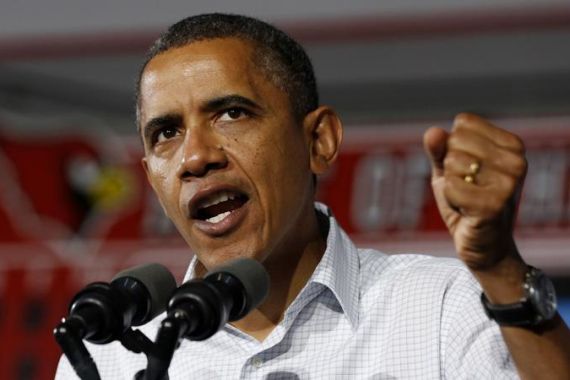The US political ads war
More than a million political advertisements have aired in the 2012 presidential race, far more than in previous polls.

Viewers tuning in to broadcast television and national cable in the United States are being treated to a barrage of political advertising ahead of the November 6 election.
A study by the Wesleyan Media Project found more than one million political ads have aired in the presidential race between Barack Obama and Mitt Romney, far more than in previous election cycles.
Advertising is the main expense of a political campaign, or outside group, trying to influence the election.
Both Obama and Romney’s campaigns are flush with cash to buy TV ad time, holding enough money back in the final days of the campaign to sway any undecided voters with targeted messages.
Obama acknowledged the public’s fatigue with wall-to-wall advertising in his speech to the Democratic National Convention in September: “The truth gets buried under an avalanche of money and advertising. If you’re sick of hearing me approve this message, believe me – so am I.”
Most advertisements air in the states where neither candidate has a clear advantage. Kantar Media/CMAG analysed the ads run in these swing states and found TV stations in Denver, Colorado saw the most ads from October 22-29.
More than 4,600 advertisements were run in the city, the state’s largest city, during that week. Opinion polls in Colorado show the race is very close, so the candidates are spending both money and time to win.
Al Jazeera did an analysis of ad buys from October 23-31 in the Norfolk, Virginia area.
Obama and Democratic groups supporting him aired more than twice as many advertisements as Romney and his Republican supporters. The cost to Obama – $1.7m compared to just over $1m spent by Romney.
Norfolk is a place both candidates are counting on to win. With 242,000 people living in the city, it’s home to the world’s largest naval base.
While Obama has spent twice as much nationally as Romney on ads, Super PACs supporting the Republican candidate have made up the difference.
Super PACs are outside groups which raise unlimited amounts of money from corporations, unions, and the rich but don’t co-ordinate with the campaign.
The vast majority of ads sponsored by Super PACs are negative. A recent ‘Restore Our Future’ ad says: “Obama wants to raise taxes, taking more money out of our business. We can’t create new jobs until Obama loses his.”
As the candidates continue to bombard viewers with advertising, Travis Ridout, co-director of the Wesleyan Media Project, says ads can be most effective when one candidate is sending more messages than the other, but “this year advertising is fairly balanced in most media markets, and most Americans already know a lot about the candidates, and so I wouldn’t expect too much ad persuasion this final week”.
Despite that, the candidates are expected to air another 100,000 advertisements in the last days of the campaign.
– Additional research by Ayya Harraz